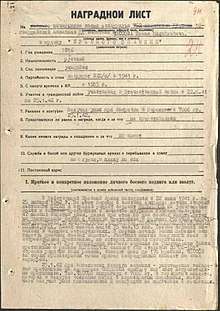Ivan Chisov
Ivan Mikhailovich Chisov (Russian: Иван Михайлович Чисов, Ukrainian: Іван Михайлович Чиссов; 1916–1986) was a Soviet Air Force lieutenant who survived a fall of approximately 7,000 meters (23,000 feet). Some references give the spelling of his last name as Chissov (Russian: Чиссов, Ukrainian: Чиссов).
Ivan Chisov | |
|---|---|
| Born | 1916 Bogdanovka, Novi Sanzhary Raion, Ukraine |
| Died | 1986 Moscow, Soviet Union |
| Allegiance | |
| Service/ | |
| Years of service | 1941–1960 |
| Rank | Podpolkovnik |
| Unit | 98th Long-range Aviation Regiment |
| Battles/wars | Second World War |
| Awards | Order of the Red Banner |
Biography
Lieutenant Colonel Chisov was a navigator on a Soviet Air Force Ilyushin Il-4 bomber. In January 1942, Luftwaffe fighters attacked his bomber, forcing him to bail out. Nikolai Zhugan, a crewman on Chisov's flight, later said that Chisov leapt from the plane at an altitude of approximately 7,000 meters (23,000 feet), though other references list Chisov's fall at 6,700 meters (Zhugan himself waited until the plane was at about 5000 meters before also bailing out).
With the air battle still raging around him, Chisov intentionally did not open his parachute, since he feared that he would be an easy target for an angry German pilot while he was dangling from his parachute harness. He planned to drop below the level of the battle, and open his chute, when he was out of sight of the fighters. Due to the thin atmosphere at that altitude, however, he lost consciousness and was unable to pull the rip cord.
Chisov struck the edge of a snowy ravine at an estimated speed of somewhere between 190 and 240 km/h (120 and 150 mph), then slid, rolled, and plowed his way to the bottom. The aerial battle had been seen by cavalry commander General Pavel Alexeyevich Belov. When Chisov was seen falling to the ground, cavalrymen rushed to the site, and were surprised to find Chisov alive, still wearing his unopened parachute. Chisov regained consciousness a short time later.
Chisov suffered severe injuries, including spinal injuries and a broken pelvis. He was operated on by surgeon Y. Gudynsky, and for a month his condition was considered critical. Despite his injuries, he was able to fly again three months later.[1] He requested to continue flying combat missions, but was instead sent to become a navigational trainer.
Chisov flew over 70 combat missions during the course of his career.
After the war, he graduated from the Military-Political Academy. On his departure from the reserve, he became a propagandist for the Central House of the Soviet Army.
Awards
- Order of the Red Banner (23.07.1943)
- Order of the Patriotic War 1st class (1985)
- Medal "For the Defence of Moscow"
- Medal "For the Defence of Leningrad"
- Medal "For the Victory over Germany in the Great Patriotic War 1941–1945"
- Jubilee Medal "Twenty Years of Victory in the Great Patriotic War 1941–1945"
- Jubilee Medal "Thirty Years of Victory in the Great Patriotic War 1941–1945"
- Jubilee Medal "Forty Years of Victory in the Great Patriotic War 1941–1945"

See also
- Nicholas Alkemade, British bomber tailgunner who survived falling from his burning Avro Lancaster B Mk. II in 1944
- Alan Magee, American, World War II airman who survived a 22,000-foot (6,700 m) fall from his damaged B-17F Flying Fortress in 1943
- Juliane Koepcke, who survived a 3 kilometre fall after her Lockheed Electra flight broke up over the Peruvian Amazon in 1971
- Vesna Vulović, Serbian flight attendant who survived the mid-air breakup of her McDonnell Douglas DC-9 in 1972
- Other
- Freefall
- List of sole survivors of aviation accidents or incidents
References
- "Aviation's most wanted: the top 10 book of winged wonders, lucky landings, and other aerial oddities" By Steven A. Ruffin, Darek Johnson, Published by Brassey's, 2005
- Gunbin NA In the stormy sky. Yaroslavl: Upper Volga. the book. Press, 1984.
- Golovanov, AE Long-range bombers. Moscow: OOO "Delta National Bank," 2004.
- DB Khazanov An unknown battle in the skies of Moscow in 1941–1942. Counterattack. Moscow: Publishing House "Technology Youth," 2001.